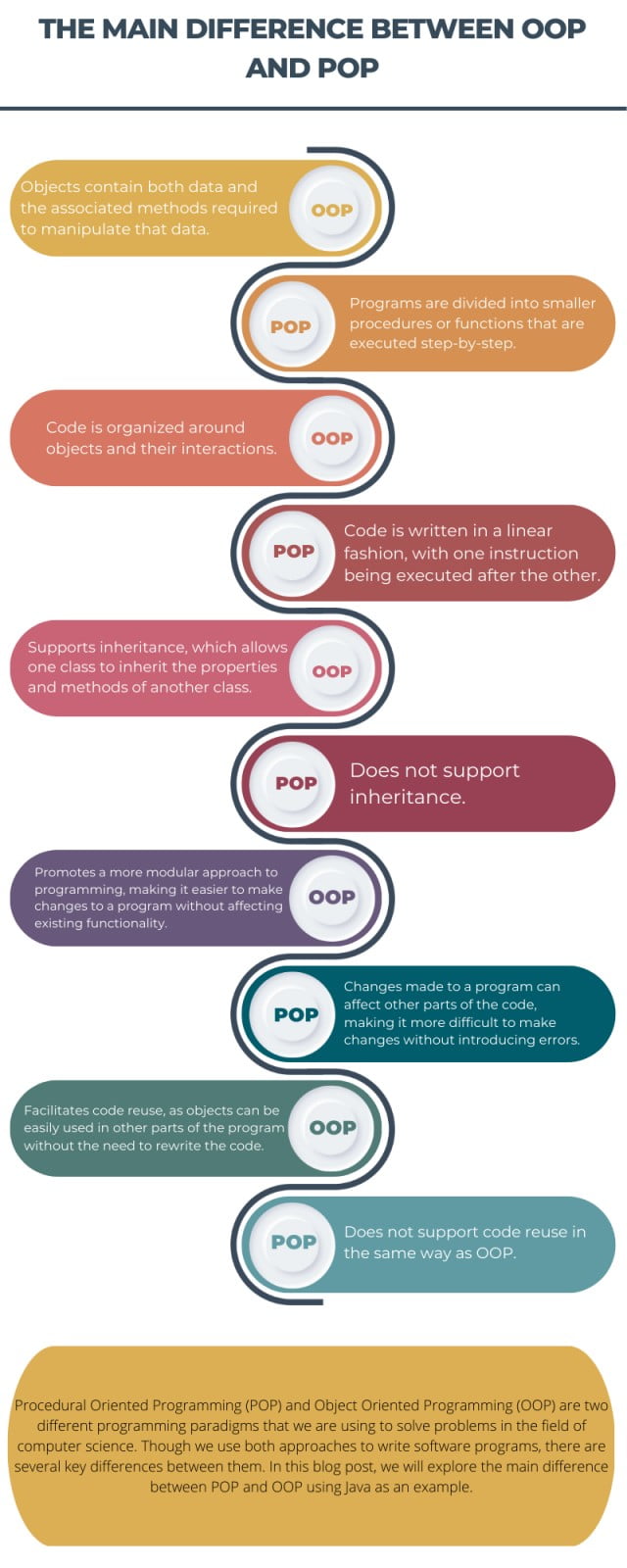Procedural Oriented Programming (POP) and Object Oriented Programming (OOP) are two different programming paradigms that we are using to solve problems in the field of computer science. Though we use both approaches to write software programs, there are several key differences between them. In this blog post, we will explore the topic Object Oriented Programming (OOP) vs Procedural Oriented Programming (POP) using Java as an example.
The main difference between OOP and POP
| OOP | POP |
|---|---|
| Objects contain both data and the associated methods required to manipulate that data. | Programs are divided into smaller procedures or functions that are executed step-by-step. |
| Code is organized around objects and their interactions. | Code is written in a linear fashion, with one instruction being executed after the other. |
| Supports inheritance, which allows one class to inherit the properties and methods of another class. | Does not support inheritance. |
| Promotes a more modular approach to programming, making it easier to make changes to a program without affecting existing functionality. | Changes made to a program can affect other parts of the code, making it more difficult to make changes without introducing errors. |
| Facilitates code reuse, as objects can be easily used in other parts of the program without the need to rewrite the code. | Does not support code reuse in the same way as OOP. |
As you can see from the table, OOP has several advantages over POP. It allows for code reuse, facilitates a more modular approach to programming, and supports inheritance. These features make it easier to write, maintain, and update software programs written in OOP languages such as Java.
In summary, it’s worth noting that both POP and OOP have their own set of pros and cons, and the right approach will depend on the specific problem you are trying to solve. However, OOP has become the most dominant programming paradigm in recent years. The most modern object-oriented programming languages are Java, Python, Ruby, and JavaScript.
What is Object-Oriented Programming (OOP) and Procedural Oriented Programming (POP)?
OOP focuses on objects and their interactions, while POP emphasizes procedures and functions. They are different programming paradigms.
What are the main advantages of OOP over POP?
OOP offers better code organization, encapsulation, reusability, and extensibility compared to the linear and structured nature of POP.
In which scenarios is POP preferred over OOP?
POP is simpler and more suitable for small, straightforward programs where the complexity of OOP is unnecessary.
What is the role of data and functions in OOP and POP?
In OOP, data and functions are encapsulated within objects, promoting data hiding. In POP, data and functions are separate, making data more accessible.
Can you mix OOP and POP in a single program?
Yes, you can use both paradigms in a program, but it’s essential to maintain consistency and clarity in code to avoid confusion and maintainability issues.
